_
|
354 FIGHTER SQUADRON |
|
|
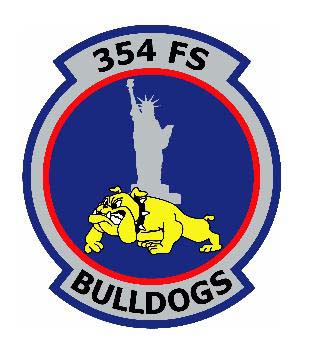 |
|
|
|
HISTORY |
|
|
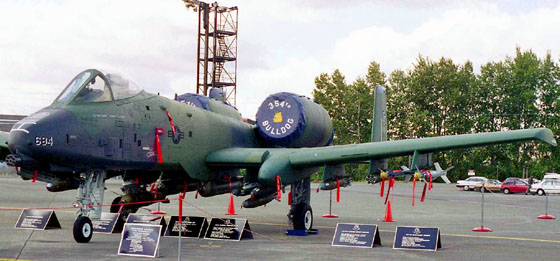 |
|
|
|
The 354th Fighter
Squadron “Bulldogs” activated on November 12, 1942, as part of the 355th
Fighter Group based in Orlando Army Air Field, FL
flying the P-40 Warhawk. As the
354th and its sister squadrons (357th and 358th) gained additional
personnel, they feverously trained in the
Curtiss
P-40 Warhawk for eventual combat overseas.
|
|
|
|
In February 1943, the group was declared combat ready and
prepared for movement with a new aircraft, the Republic P-47
Thunderbolt. Pilots and crews of the 354th carried out training during
the Group's move to various bases up the East Coast. With P-47 upgrade
training complete, squadrons of the 355th FG departed for England on
June 16 arriving at RAF Steeple Morden, England, in July 1943.
|
|
|
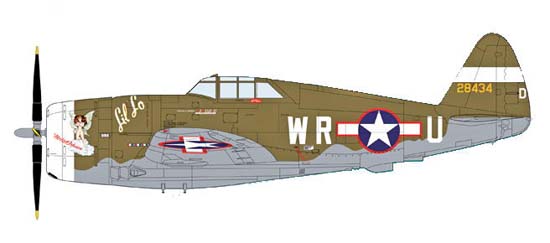 |
|
Republic P-47D Thunderbolt 42-28434 Miss Behave /
Li'l
Lolown by Capt Henry
Kucheman, 354th FS, 355th FG, England, 1943
|
|
|
|
At Steeple Morden, the Groups primary mission was escorting
bombers attacking industrial areas in Germany.
The group also flew fighter sweeps, area patrols, and
bombing missions, striking such targets as airfields, locomotives,
bridges, radio stations, and armored cars.
From September 1943 to April 1945,
the 354th supported the Allied advances in European offensive in the
Republic P-47 Thunderbolt and later, the North American P-51 Mustang. It
was in 1944 the Group quickly
gained acclaim as the "Steeple Morden Strafers," a nickname derived from
the units base and its lethal accuracy at low-level attacks.
The Group also provided
fighter cover for Allied forces during the landing in Normandy.
|
|
|
|
The Bulldogs
remained in combat until the German Capitulation in May 1945 moving from
England to various Occupation airfields in Germany as part of the United
States Air Forces in Europe Army of Occupation
and moved to Gablinger, Germany. At
War's end, the squadron returned to the United States by April 1946 it
later demobilized and inactivated
on November 20, 1946.
|
|
|
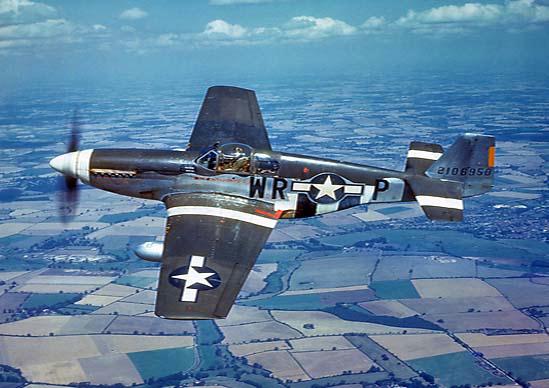 |
|
P-51B 42-106950 was
originally named "Man O' War" and later "The Iowa Beaut" .
|
|
|
|
On November 1, 1952, the 354th was reactivated under the Air
Defense Command (ADC) at Long Beach Municipal Airport, CA replacing the
188th Fighter Interceptor Squadron of the New Mexico Air National Guard
at Long Beach. With this reactivation, the 354th reacquainting itself
with its wartime mount the North American F-51.
|
|
|
|
In December of 1952, the Bulldogs, with their Mustangs moved to
Oxnard AFB, CA. In March of 1953, the 354th participated in the USAF’s
first Aerial Gunnery Meet (forerunner to the William Tell Weapons Meet).
Competing against the Air Forces top jet fighters of the day, Bulldog
F-51’s captured the top spot in the competition, proving that there was
still some life left in the old fighter!
|
|
|
|
In June of 1953, the squadron transitioned out of their trusty
Mustangs into the squadron’s first jet aircraft, Lockheed F-94C Starfire
at their California base. In their new jets, the Bulldogs continued to
defend the States Southern Coast with a weapon more suited for their
mission.
|
|
|
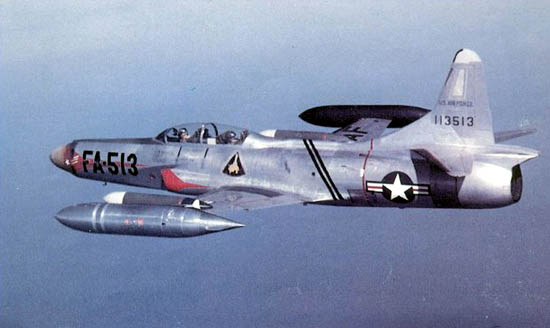 |
|
A F-94C Starfire of the 354th FIS, in mid-1955. |
|
|
|
In an effort to
reactivate and realign historically significant units within the
Command, the ADC implemented a program named "Project Arrow". Because of
Project Arrow, the personnel, and F-86D's flying with 460th FIS based
at
McGee-Tyson AFB TN would be reflagged as
the 354th FIS under the 355th Fighter Group. In late 1957, the
squadron a been
advised of their impending inactivation, within few months the squadron
was no more. The 354th Bulldogs were again inactivated on January
8, 1958.
|
|
|
|
The "Bulldogs"
reactivated in April
1962, at George AFB, CA as the 354th Tactical Fighter Squadron
as part of the 355th
Tactical Fighter Wing.
While at George, the
squadron operated the Republic F-105 Thunderchief conducting combat
operations from bases in Alaska and Turkey. In October 1964, the unit
moved to McConnell AFB, KS and flew combat missions from Kadena Air
Base, Japan, and Korat, Thailand.
|
|
|
|
The squadron ended
its temporary deployments to Thailand and permanently relocated to
Takhli RTAFB in November 1965 to participate in significant operations
in Southeast Asia in a mission
named "Rolling Thunder".
|
|
|
|
|
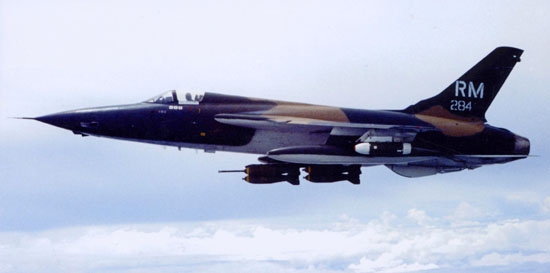 |
|
Triple MiG Killer
F-105D 62-4284 is pictured fully loaded for its next mission in the
skies in Southeast Asia.
|
|
|
|
In the first month
of flying, the 354th and the 357th TFS "Dragons" completed over 400
combat sorties during the first month. These dangerous missions, some
seeking out and destroying SAM sites (in the “Wild Weasel” mission),
proved to be costly for the squadron, during 1966 experienced more
losses than any other squadron in SEA. In one two month period, the
354th lost almost 40% its assigned pilot’s squadrons.
|
|
|
|
The Bulldogs
continued flying missions in Rolling Thunder until inclement weather
reduced flying over North Vietnam in the latter part of 1968.
|
|
|
|
In April 1971, the
354th returned to the United States under the command of the 355th
Tactical Fighter Wing at Davis Monthan AFB. At this base, the unit
prepared for a conversion to the Air Forces newest close air support
aircraft, Vought A-7D Corsair II. Less than two years later, the
Bulldogs would return to combat, this time in the A-7 flying out of
Korat RTAFB under the command of the 354th Tactical Fighter Wing.
|
|
|
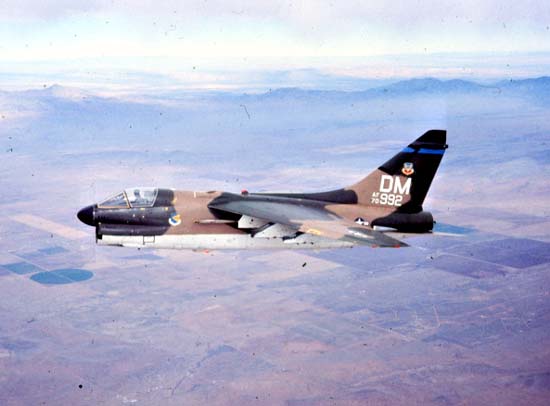 |
|
A-7D 70-0992
is pictured in its 354 TFS colors over Arizona.
|
|
|
|
On July 5, 1973,
the Bulldogs returned to Davis Monthan and the 355th. For their combat
actions in the Vietnam War,
the 354th received five Presidential Unit Citations and three
Air Force Outstanding Unit Awards with the combat "V" device, and one
Metal of Honor recipient, pilot
Major Merlyn H. Dethlefsen who received the Nation's highest honor for
his actions in an on Wild Weasel mission on March 10, 1967.
|
|
|
|
The 354th
continued in USAF A-7 training operations
until the 355th Tactical Training
Wing conversion from the Corsair into the Fairchild Republic A-10
Thunderbolt II. While the other squadrons under the 355th TFTW moved on
to the A-10 the 354th didn't follow. The Bulldogs remained as a "paper
Squadron", active without personnel or aircraft until their deactivation
in 1982.
|
|
|
|
In November 1991, squadron was reactivated at Davis Monthan with
the 602nd Air Control Wing (a forward air control unit) as the 354th
Fighter Squadron flying the Republic OA-10 Thunderbolt II, replacing the
23rd Tactical Air Support Squadron. On January 4, 1993, the 354th
Fighter Squadron was deactivated at Davis Monthan for a move to a new
home at McChord AFB.
|
|
|
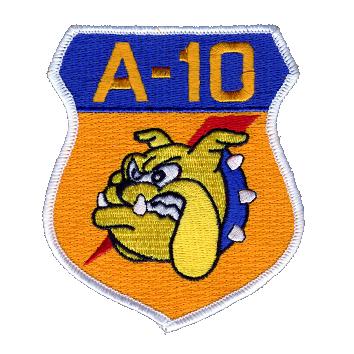 |
|
|
|
At McChord AFB, a search for a mission to fill the void created
after force reductions at the Base in the late 80s and early 90s was
underway. With a major Army Post (Ft. Lewis) along the perimeter of the
Base, the A-10 and its close air support mission was found to be a good
fit. Initially, the A-10 squadron proposed for McChord was to fall under
the control of the Air National Guard, in the later planning stages a
switch to an active duty squadron was made.
|
|
|
|
After the formal approval of the in 1992, the 355th FW
established a detachment (the 355th OLGG) to manage the activation of
the squadron. In mid 1992, people and planes began to stream into
McChord with the first 20 personnel arriving in May and the first 4
aircraft arriving in October, by the end of the month, 355th OLGG
Commander Lt Col. Danny Clifton commanded a flight of two A-10's for
the unit's first local area orientation sortie.
|
|
|
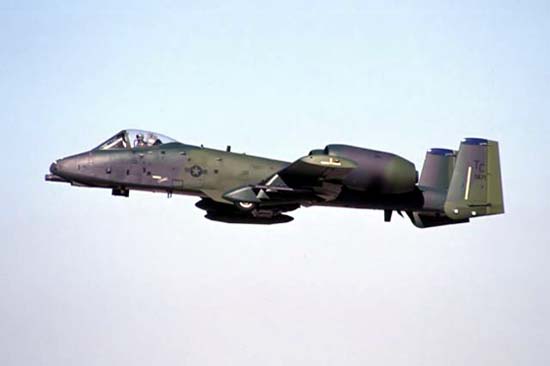 |
|
A-10A
78-0671 from 354th FS with its "TC" tailcode takes off in the early
90's.
|
|
|
|
On January 5 1993,
the 354th Fighter Squadron "Bulldogs" activated at McChord AFB as a
geographical separated unit from its parent Wing, the 355th Fighter Wing
at Davis-Monthan, AZ. With 26 aircraft (twelve A-10s, nine OA-10 and
five back-up aircraft) with a mission to " Deploy, employ, support, and
sustain attack airpower in support of Combatant Commanders anywhere in
the world at a moment's notice" the Bulldogs were also tasked to support
the troops at Fort Lewis, WA and the Yakima Training Center in Eastern
Washington State.
|
|
|
|
During their time
at McChord, the 354th was one of the USAF's most deployed Squadrons flew
more than 15,000 sorties during 11 deployments to operations and
exercises in Argentina, Chile, Italy, Japan, Turkey, and the Persian
Gulf.
|
|
|
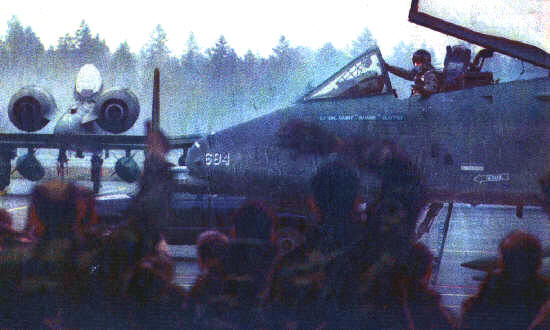 |
Squadron Commander Lt
Col Danny "Maddog" Clifton waves farewell to the
remaining members of the 354th FS "Bulldogs" as he taxis his
A-10A, s/n 76-0684 on his way to Davis Monthan AFB AZ after
the squadrons deactivation at McChord.
|
|
|
|
On May 27, 1993
Air Combat Command Headquarters announced its intensions to
converted and realigned the 347th Fighter
Wing into an air/land composite wing
(347th Wing) consisting of
C-130's F-16s and A-10's. To form the 374 WG's A-10 squadron, the 354th
would be sacrificed. On
October 1, 1994, the squadron was inactivated at McChord and reactivated
at Davis-Monthan AFB, AZ replacing the 333rd Fighter Squadron.
|
|
|
|
On December 14,
1994, the last five Bulldog A-10's left Washington State for the last
time headed to their new assignments in at Davis Monthan. Before
boarding his "Hog", 354th Commander Lt. Col. Danny Clifton summed up the
Bulldog era at McChord in a few words "The squadron did almost
everything it set out to do at McChord; the one goal we did not
accomplish was to stay here forever".
|
|
|
|
|
|
LINAGE & HONORS |
|
|
|
Lineage - Constituted
as 354 Fighter Squadron, and activated, on 12 Nov 1942. Redesignated as
354 Fighter Squadron, Single Engine, on 21 Aug 1944. Inactivated on 20
Nov 1946. Redesignated as 354 Fighter-Interceptor Squadron on 11 Sep
1952. Activated on 1 Nov 1952. Inactivated on 8 Jan 1958. Redesignated
as 354 Tactical Fighter Squadron, and activated, on 13 Apr 1962.
Organized on 25 Apr 1962. Redesignated as 354 Tactical Fighter Training
Squadron on 1 Apr 1979. Inactivated on 30 Apr 1982. Redesignated as 354
Fighter Squadron, and activated, on 1 Nov 1991.
|
|
|
|
Assignments -
355 Fighter Group, 12 Nov 1942-20 Nov 1946. 27 Air
Division, 1 Nov 1952; 533 Air Defense Group, 16 Feb 1953; 355 Fighter
Group, 18 Aug 1955-8 Jan 1958. Tactical Air Command, 13 Apr 1962; 831
Air Division, 25 Apr 1962; 355 Tactical Fighter Wing, 8 Jul 1962;
Thirteenth Air Force, 10 Dec 1970; 4453 Combat Crew Training Wing, 1 Apr
1971; 355 Tactical Fighter (later, 355 Tactical Training) Wing, 1 Jul
1971-30 Apr 1982. 602 Air Control Wing, 1 Nov 1991; 355 Operations
Group, 1 May 1992-.
|
|
|
|
Stations -
Orlando, FL, 12 Nov 1942; Zephyrhills, FL, 30 Jan 1943; Orlando, FL, 13
Feb 1943; Norfolk Muni Aprt, VA, 18 Feb 1943; Philadelphia Muni Aprt,
PA, 4 Mar 1943; Millville, NJ, 5 May 1943; Philadelphia Muni Aprt, PA,
27 May-16 Jun 1943; Steeple Morden, England, 6 Jul 1943; Gablingen,
Germany, 17 Jul 1945; Schweinfurt, Germany, 15 Apr-1 Aug 1946; Mitchel
Fld, NY, 1 Aug-20 Nov 1946. Long Beach Muni Aprt, CA, 1 Nov 1952; Oxnard
AFB, CA, 16 Dec 1952 (operated from Moody AFB, GA, 8 May-10 Jun 1955);
McGhee-Tyson Aprt, TN, 18 Aug 1955-8 Jan 1958. George AFB, CA, 25 Apr
1962 (operated from Eielson AFB, AK, 24 Jan-14 Feb 1964, and from
Incirlik AB,Turkey, 5 May-18 Sep 1964); McConnell AFB, KS, 15 Oct
1964-27 Nov 1965 (deployed at Kadena AB, Okinawa, and then Korat RTAFB,
Thailand, 6 Mar-18 Jun 1965); Takhli RTAFB, Thailand, 28 Nov 1965-15 Oct
1970; Davis-Monthan AFB, AZ, 15 Oct 1970-30 Apr 1982 (deployed at Korat
RTAFB, Thailand, 14 Jan-4 Jul 1973). Davis-Monthan AFB, AZ, 1 Nov 1991;
McChord AFB, WA, 5 Jan 1993; Davis-Monthan AFB, AZ, 1 Oct 1994-.
|
|
|
|
Aircraft - P-47,
1943-1944; P-51, 1944-1946. F-51, 1952-1953; F-94, 1953-1955; F-86,
1955-1957. F-105, 1962-1970; A-7, 1971-1979; A-10, 1979-1982. AO-10,
1991-.
|
|
|
|
Operations -
Combat in the European Theater of Operations (ETO), 14 Sep
1943-25 Apr 1945. Combat in Southeast Asia, 13 Mar-12 Jun 1965; 28 Nov
1965-7 Oct 1970; c. 14 Jan-3 Jul 1973. Combat crew training, 1971-1982
and forward air control training, 1991-. Performed close air support,
air interdiction, and combat search and rescue missions in support of
combined Army and Air Force units worldwide, 2000-.
|
|
|
|
Service Streamers -
None.
|
|
|
|
Campaign Streamers - World
War II: Air
Offensive, Europe; Normandy; Northern France; Rhineland;
Ardennes-Alsace; Central Europe; Air Combat, EAME Theater.
Vietnam:
Vietnam Defensive; Vietnam Air; Vietnam Air Offensive; Vietnam Air
Offensive, Phase II; Vietnam Air Offensive, Phase III; Vietnam
Air/Ground; Vietnam Air Offensive, Phase IV; TET 69/Counteroffensive;
Vietnam Summer/Fall, 1969; Vietnam Winter-Spring, 1970; Sanctuary
Counter-offensive; Southwest Monsoon; Vietnam Ceasefire.
Southwest Asia:
Ceasefire.
|
|
|
|
Armed Forces Expeditionary Streamers -
None.
|
|
|
|
Decorations -
Distinguished Unit Citation: Germany, 5 Apr 1944. Presidential
Unit Citations (Southeast Asia): 5 May-17 Jun 1965; 1 Jan-10 Oct 1966;
11-12 Aug 1967 and 24-28 Oct 1967; 12 Apr 1968-30 Apr 1969; and 10 Oct
1972-30 Apr 1973. Air Force Outstanding Unit Awards with Combat "V"
Device: 12 Oct 1966-11 Apr 1967; 12 Apr 1967-11 Apr 1968; 1 Jul 1969-15
Oct 1970; 1 Jun-31 Aug 1999. Air Force Outstanding Unit Awards: 1 Jul
1956-30 Jun 1957; 1 Jul 1971-11 Jan 1973; 1 Oct 1976-31 May 1978; 1 May
1990-30 Apr 1992; 1 Jun 1995-31 May 1997; 1 Jun 1998-31 May 2000; 1 Jun
2002-31 May 2004; 1 Jun 2004-31 May 2006; 1 Jun 2007-31 May 2009.
Republic of Vietnam Gallantry Cross with Palm: 1 Apr 1966-28 Jan 1973.
|
|
|
|
|
|
ASSIGNED AIRCRAFT |
|
Please email
greendragonsden@yahoo.com
with any additions to the lists below. |
|
|
|
A-10A / OA-10A |
|
CLOSE AIR SUPPORT (CAS) / FORWARD AIR CONTROL (FAC) |
|
78-0651 |
78-0652 |
78-0671 |
|
.78-0684. |
78-0685 |
78-0690 |
|
78-0706 |
79-0177 |
79-0188 |
|
79-0201 |
79-0215 |
80-0142 |
|
80-0151 |
80-0164 |
80-0165 |
|
80-0186 |
80-0224 |
80-0246 |
|
82-0658 |
82-0662 |
82-0663 |
|
|
|
GA-10A |
|
GROUND INSTRUCTIONAL TRAINERS |
|
75-0270 |
|
75-0274 |
|
|
|
|
 |
|